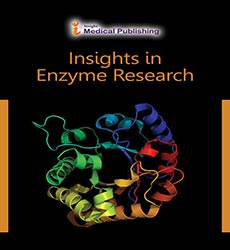Abstract
Biocatalytic Activity of Mushroom Tyrosinase in Ionic Liquids: Specific Ion Effects and the Hofmeister Series
We report results on the correlation between mushroom tyrosinase inhibition kinetics and ionic liquid (IL) ion effects predicted by the Hofmeister series. A spectrophotometric assay was used to measure product formation from which we extracted the kcat and Km kinetic parameters. The kcat/Km ratio was calculated for both the neat buffer solution and IL-modified solution, which allowed us to determine the relative enzymatic activity. The results show that tyrosinase activity was inhibited by the presence of IL ions. Consistent with Hofmeister predictions, the more kosmotropic cations and chaotropic anions had the greatest inhibition effect. Both ion identity and concentration contributed to overall observed relative activity change in the systems studied here, with an overall range of relative activity change from ~1.0 to ~0.15 depending on the specific ions used. [Im21 +] [NO3 -] showed the least effect on tyrosinase activity over a wide concentration range (20–150 mM) compared to when using an IL with a more chaotropic anion, [Im21 +] [Tf2N-], where the enzyme activity was ~0.2 at all concentrations studied between 20-80 mM. The inhibitory effect of [Tf2N-] was quite significant. We also observed low relative activities (~0.15) in IL solutions that used increasingly kosmotropic cations, [Im41 +] [Cl-] and [Im61 +][Cl-]. Again, concentration worked in parallel with specific ion identities and the less kosmotropic cation [Im41 +] required higher concentrations (~80 mM, [Im41 +] [Cl-]) to achieve the same level of inhibition as only 40 mM of [Im61 +] [Cl-]. The Hofmeister series for both cations and anions used here appears to be a good predictor of inhibition in our IL solutions. In addition, a reliable measure of inhibition also followed increased anion hydrophobicity and polarizability.
Author(s): Mark P Heitz, Jason W Rupp and Kim W Horn
Abstract | Full-Text | PDF
Share This Article
Google Scholar citation report
Citations : 157
Insights in Enzyme Research received 157 citations as per Google Scholar report
Abstracted/Indexed in
- Google Scholar
- China National Knowledge Infrastructure (CNKI)
- Secret Search Engine Labs
- Zenodo
Open Access Journals
- Aquaculture & Veterinary Science
- Chemistry & Chemical Sciences
- Clinical Sciences
- Engineering
- General Science
- Genetics & Molecular Biology
- Health Care & Nursing
- Immunology & Microbiology
- Materials Science
- Mathematics & Physics
- Medical Sciences
- Neurology & Psychiatry
- Oncology & Cancer Science
- Pharmaceutical Sciences

